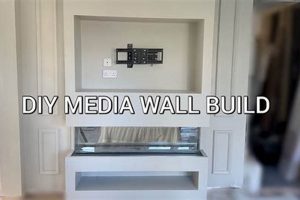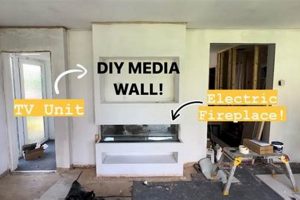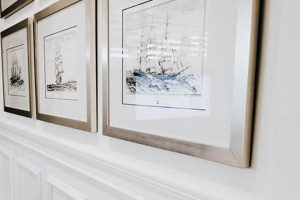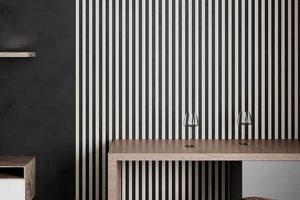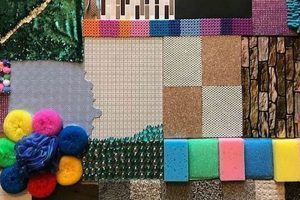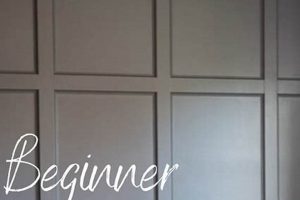The act of installing decorative trim to a wall surface, undertaken by an individual without professional assistance, results in an aesthetically enhanced interior space. This process frequently involves the selection, cutting, and affixing of materials such as wood, MDF, or polystyrene to create patterns, frames, or panels directly on the wall. For instance, a homeowner might choose to apply chair rail moulding to a dining room to add architectural interest and visual separation.
Implementing such projects offers a cost-effective method for improving a room’s visual appeal and increasing its perceived value. Historically, moulding served a functional purpose, concealing imperfections and reinforcing joints; however, it has evolved into a prominent design element. The application allows for significant personalization, enabling individuals to tailor their living spaces to reflect their unique style preferences and achieve a desired level of sophistication.
Subsequent sections will detail material selection considerations, provide step-by-step installation guidance, and address potential challenges encountered during the execution of these decorative wall enhancements. Furthermore, various design approaches and stylistic adaptations will be explored, offering a thorough understanding of this interior improvement technique.
Essential Guidance for Decorative Wall Paneling
The following recommendations serve to optimize the process of creating decorative wall paneling, ensuring a successful and visually appealing outcome.
Tip 1: Precise Measurement and Planning: Prior to any material acquisition or cutting, meticulous measurement of the wall surface is paramount. Develop a detailed plan outlining the placement and dimensions of each moulding element. Accurate measurements minimize material waste and prevent installation errors.
Tip 2: Material Selection: Carefully consider the characteristics of various moulding materials, such as wood, MDF, or polystyrene. Wood offers a classic aesthetic but may require specialized cutting tools. MDF provides a smooth, paintable surface at a lower cost. Polystyrene is lightweight and moisture-resistant, ideal for bathrooms or kitchens.
Tip 3: Accurate Cutting Techniques: Mitre cuts, particularly for corners, necessitate precision. A powered mitre saw is highly recommended for achieving clean, accurate angles. Practice cuts on scrap material before proceeding with the final moulding pieces.
Tip 4: Proper Adhesion and Fastening: Utilize a combination of construction adhesive and finishing nails to securely affix the moulding to the wall. Apply adhesive evenly to the back of the moulding and use a nail gun with appropriate nail length to penetrate both the moulding and the wall surface.
Tip 5: Seam Filling and Sanding: Upon installation, inspect all joints and seams for gaps or imperfections. Apply paintable caulk to fill these areas and allow it to dry completely. Sand the filled areas smooth using fine-grit sandpaper for a seamless finish.
Tip 6: Priming and Painting: Prior to applying the final coat of paint, prime all moulding surfaces with a high-quality primer. Priming ensures proper paint adhesion and enhances the overall finish. Select a paint that is compatible with the chosen moulding material and desired aesthetic.
These guidelines emphasize the importance of meticulous planning, precise execution, and careful attention to detail in achieving professional-looking decorative wall paneling. Adherence to these recommendations will contribute to a visually stunning and durable result.
The subsequent section will delve into advanced techniques and design considerations for enhancing the aesthetic impact of decorative wall paneling projects.
1. Precise measurements
The attainment of precise measurements forms the foundational prerequisite for a successful execution of any decorative wall paneling endeavor. In the absence of accurate dimensional assessments, the subsequent stages of material cutting and installation are rendered prone to error, potentially resulting in misalignment, gaps, and an overall compromised aesthetic. The relationship between meticulous measurement and the final visual outcome is causal: inaccurate measurements directly lead to visible imperfections, while precise measurements enable a seamless and professional-looking installation. An example can be seen in the installation of a picture frame moulding where inconsistent measurements across a series of frames will create a disjointed and amateurish appearance on the wall.
The practical significance of precise measurements extends beyond mere aesthetics. Dimensional inaccuracies can lead to material wastage, thereby increasing project costs. Furthermore, forcing ill-fitting pieces into place can compromise the structural integrity of the wall or the moulding itself, leading to long-term instability. For instance, attempting to install a chair rail with improperly mitered corners will not only appear visually unappealing but also create stress points that could weaken the adhesive bond over time. A careful approach, including double-checking all dimensions and accounting for wall irregularities, becomes imperative for achieving a durable and aesthetically pleasing result.
In summation, the criticality of accurate dimensional assessment in the context of decorative wall paneling cannot be overstated. Its impact cascades throughout the project, influencing cost-effectiveness, structural integrity, and the ultimate visual appeal. Challenges in achieving precise measurements often stem from complex room layouts or variations in wall surfaces; however, employing appropriate measuring tools and techniques, along with meticulous planning, mitigates these risks and ensures a successful outcome that elevates the overall aesthetic of the interior space.
2. Material selection
The act of choosing appropriate materials directly dictates the aesthetic outcome, durability, and long-term performance of a decorative wall paneling project. Material selection is not merely a superficial decision; it constitutes a foundational component that influences both the practical execution and the visual impact. The chosen material determines the ease of cutting and installation, the surface finish, the resistance to moisture and impact, and the overall lifespan of the decorative wall element. For example, the selection of medium-density fiberboard (MDF) offers a smooth, paintable surface ideal for intricate designs but lacks the inherent moisture resistance of solid wood, rendering it unsuitable for bathrooms or kitchens. Conversely, using solid wood, while offering superior durability and moisture resistance, can present challenges during cutting and may require specialized tools and techniques. A failure to carefully consider material properties can result in premature degradation, aesthetic compromises, and increased maintenance requirements.
Practical application demonstrates that cost-effectiveness is not the sole determinant in material selection. While polystyrene moulding presents an affordable option, its inherent fragility and susceptibility to denting render it less suitable for high-traffic areas or environments prone to impact. Similarly, despite the aesthetic appeal of solid wood, its cost and the potential for warping or cracking in fluctuating humidity levels necessitate careful consideration of environmental factors and installation techniques. The selection of pre-primed materials, irrespective of the base composition, can significantly reduce preparation time and ensure uniform paint adhesion, thereby contributing to a professional-looking finish. Understanding the trade-offs between cost, durability, aesthetic properties, and installation complexity guides informed decision-making and optimizes the long-term value of the decorative wall paneling.
In summary, material selection for decorative wall paneling extends beyond budgetary considerations. It necessitates a comprehensive understanding of material properties, environmental conditions, and aesthetic goals. The suitability of the chosen material directly affects the ease of installation, the long-term durability, and the overall visual impact. Challenges in material selection often arise from balancing cost considerations with performance requirements; however, a thorough assessment of these factors ensures a successful outcome that enhances the interior space for years to come. This understanding enables a more informed and strategic approach to the project, leading to a more satisfying and enduring result.
3. Accurate cuts
The creation of a visually appealing and structurally sound decorative wall requires precise cutting of moulding materials. Inaccurate cuts compromise the intended design, resulting in misaligned joints, uneven surfaces, and an overall unprofessional aesthetic. This direct relationship underscores the critical importance of accurate cuts as a fundamental component. For example, a mitered corner that is even slightly off will create a noticeable gap, detracting from the visual appeal and potentially weakening the structure. The causal link is clear: imprecise cuts invariably lead to an inferior finished product.
The practical significance of accurate cuts extends beyond aesthetics. A properly cut moulding piece fits seamlessly with its adjacent pieces, ensuring a flush and stable surface. This is particularly crucial in areas where the wall is subject to impact or contact, such as chair rails or baseboards. Inaccurate cuts can also lead to material wastage. When a piece of moulding is cut incorrectly, it may be unusable, requiring the purchase of additional material. This increases project costs and contributes to unnecessary waste. Accurate cuts also simplify the installation process. Pieces that are precisely cut fit together easily, reducing the need for adjustments or modifications during installation, saving time and effort.
In summary, accurate cuts are not merely a desirable attribute but a necessity for any wall project. The accuracy directly impacts the final appearance, structural integrity, and efficiency. Challenges in achieving accurate cuts often stem from using inadequate tools or failing to properly measure and mark materials. Overcoming these challenges requires careful planning, the use of appropriate cutting tools such as miter saws, and a meticulous approach to measurement and marking. This contributes to a successful execution that enhances the interior space.
4. Secure attachment
Secure attachment forms a critical component in the successful execution of decorative wall paneling projects. The method employed to affix the moulding to the wall directly influences the longevity, stability, and overall aesthetic integrity of the finished installation. Inadequate attachment techniques can lead to detachment, warping, or cracking of the moulding over time, thereby compromising the intended design and necessitating costly repairs. The causal relationship is evident: insufficient attachment methods invariably result in a degraded aesthetic and reduced lifespan of the wall paneling. For instance, using only adhesive on heavier moulding pieces, without the addition of mechanical fasteners, often leads to detachment, particularly in environments with fluctuating humidity levels or temperature changes. The success of a project hinges on choosing appropriate attachment strategies.
The practical significance of understanding secure attachment extends beyond preventing immediate detachment. Proper fastening techniques, such as utilizing a combination of construction adhesive and finishing nails, distribute the load evenly across the moulding, minimizing stress points and reducing the likelihood of warping or cracking. Selecting the correct type of fasteners, considering the wall material (drywall, plaster, wood), is crucial. Insufficient nail penetration or using inappropriate adhesive can compromise the bond between the moulding and the wall, leading to long-term instability. Furthermore, ensuring proper wall preparation, such as cleaning the surface to remove dust and debris, enhances adhesive bonding and contributes to a more secure attachment. A properly secured wall paneling project will withstand normal wear and tear, maintaining its visual appeal for an extended period.
In summary, secure attachment is not simply a step in the process but a fundamental aspect determining the durability and visual appeal. Challenges in achieving secure attachment often stem from improper material selection, inadequate surface preparation, or the use of incorrect fastening techniques. Addressing these challenges requires careful planning, the use of appropriate tools and materials, and adherence to best practices for installation. This approach contributes to the successful execution of a project that enhances the interior space. These considerations are paramount for the longevity and aesthetic value of the paneling.
5. Joint concealment
The successful execution of decorative wall paneling relies substantially on the effective concealment of joints between individual moulding elements. Visible joints detract from the overall aesthetic, creating a fragmented and unprofessional appearance. The absence of effective joint concealment directly undermines the visual coherence of the wall paneling. For example, if the joints between sections of chair rail moulding are clearly visible, the eye is drawn to these discontinuities, disrupting the flow of the design and diminishing the intended elegance. The causal link is undeniable: inadequate joint concealment results in a less visually appealing and less convincing application of decorative wall paneling.
The application of joint concealment techniques involves a multifaceted approach. Initially, precise cutting and fitting of the moulding elements are crucial to minimize gaps. Subsequent steps typically involve the application of paintable caulk to fill any remaining seams. The correct selection of caulk, ensuring it is compatible with both the moulding material and the paint, is paramount to avoid cracking or discoloration over time. Following the application of caulk, a smooth sanding process ensures a seamless transition between the moulding pieces. In practical terms, if the joints between panels in a wainscoting project are not properly caulked and sanded, the finished wall will appear disjointed and amateurish. By mastering joint concealment the wall paneling will look like a professional installed it, with an even and seamless visual appearance.
In summary, joint concealment is not simply a cosmetic consideration, it is a critical element in decorative wall paneling. Challenges in achieving seamless joints often stem from imprecise cutting, inadequate filling of gaps, or improper sanding techniques. Effective solutions involve meticulous planning, the use of appropriate tools and materials, and a careful approach to installation. This process enhances the cohesion of the overall design, resulting in a higher-quality, more visually pleasing, and ultimately, more valuable addition to the interior space. The attention to detail in these small but significant areas determines the overall aesthetic success of the wall paneling.
6. Surface preparation
Surface preparation is a foundational component directly impacting the success of any decorative wall paneling project. The condition of the wall surface dictates the adhesion of moulding materials, influencing the durability and aesthetic outcome. Inadequate surface preparation, such as the presence of dust, grease, or loose paint, compromises the bonding strength of adhesives and fasteners. This diminished adhesion leads to potential detachment, warping, or cracking of the moulding over time, thus undermining the intended design. A direct causal relationship exists: insufficient surface preparation invariably results in a degraded final product. An example can be found in failing to prime bare drywall prior to installing moulding. The porous nature of unprimed drywall absorbs moisture from the adhesive, weakening the bond and potentially leading to the moulding detaching from the wall. Such neglect leads to an inferior, short-lived installation.
Practical application underscores the importance of appropriate surface preparation techniques. These techniques encompass cleaning the wall to remove contaminants, repairing imperfections such as holes or cracks, and priming the surface to enhance adhesion. Cleaning often involves washing the wall with a mild detergent solution, followed by thorough rinsing and drying. Repairing imperfections requires filling holes with patching compound, sanding the filled areas smooth, and ensuring a level surface. Priming seals the wall, creating a uniform surface that promotes optimal adhesive bonding. This ensures the moulding remains securely attached, enhancing both its longevity and visual appeal. Furthermore, applying a level check to the wall before any action to guarantee that a straight line is ensured.
In summary, surface preparation is not merely a preliminary step, but an essential aspect determining the durability and aesthetic. Challenges often stem from overlooking imperfections or neglecting proper cleaning and priming. Addressing these challenges requires diligent planning, the use of appropriate tools and materials, and adherence to best practices for wall preparation. By doing so, the user ensures that the moulding securely adheres to the wall, creating a higher-quality, more visually pleasing decorative wall paneling project. Neglecting the surface is neglecting the final product, and the final product will show it.
7. Aesthetic integration
Aesthetic integration, in the context of decorative wall paneling projects, refers to the harmonious blending of newly installed moulding with the existing architectural style and interior design of a space. The success of a decorative wall relies heavily on this integration, where the moulding should appear as a natural extension of the room, rather than a jarring or disjointed addition. The selection of moulding styles, profiles, and finishes must align with the existing design elements, including color palettes, furniture styles, and overall architectural character. For instance, installing ornate, Victorian-style moulding in a minimalist, modern room would likely result in a visually discordant effect. A direct cause-and-effect relationship is at play: poorly integrated moulding diminishes the overall aesthetic appeal of the space, while well-integrated moulding enhances it.
The importance of aesthetic integration extends beyond mere visual appeal. It also affects the perceived value and coherence of the space. When moulding is thoughtfully selected and installed to complement the existing design, it elevates the room’s sophistication and creates a sense of completeness. Conversely, ill-considered moulding choices can detract from the room’s value and create a feeling of disharmony. Consider a situation where a homeowner installs simple, shaker-style moulding in a traditional colonial-style home. While the quality of the installation might be high, the lack of aesthetic integration with the existing architectural details would likely result in a less visually compelling outcome. The practical significance of this understanding lies in the ability to make informed decisions about moulding selection and placement, ensuring a cohesive and visually pleasing result.
In conclusion, aesthetic integration is a non-negotiable element of successful wall paneling projects. Challenges in achieving seamless integration often stem from a lack of understanding of design principles or a failure to consider the existing architectural features of the space. By carefully considering these factors and selecting moulding styles that complement the overall design, individuals can create spaces that are both visually appealing and harmonious. The long-term impact of thoughtful aesthetic integration extends beyond mere aesthetics, enhancing the perceived value and livability of the space. Therefore, before commencing any such home improvement project, ensure your choices align with the overall design to avoid clashing designs and ensure an appealing and harmonic design.
Frequently Asked Questions
The following frequently asked questions address common concerns and provide clarification on essential aspects of decorative wall paneling projects.
Question 1: What tools are essential for installing decorative wall paneling?
Key tools include a measuring tape, level, miter saw, nail gun, construction adhesive, caulk gun, sandpaper, and a paint brush or roller. Precise measurements and accurate cuts are crucial; therefore, a quality miter saw is highly recommended.
Question 2: What are the most common mistakes to avoid during wall paneling installation?
Common errors include inaccurate measurements, imprecise cuts, inadequate surface preparation, insufficient adhesive application, and neglecting to properly fill and sand joints. These mistakes can compromise the final appearance and durability.
Question 3: How should wall surfaces be prepared before installing decorative wall paneling?
Wall surfaces should be cleaned to remove dust and debris, imperfections should be repaired with patching compound, and a primer should be applied to ensure proper adhesion of the moulding. A level surface is necessary for a professional-looking installation.
Question 4: What type of adhesive is recommended for securing moulding to walls?
Construction adhesive specifically designed for bonding wood or MDF to drywall or plaster is recommended. The adhesive should be applied evenly to the back of the moulding and used in conjunction with finishing nails for a secure attachment.
Question 5: How can a seamless transition be achieved between the moulding and the wall?
A seamless transition can be achieved by filling any gaps between the moulding and the wall with paintable caulk, allowing the caulk to dry completely, and then sanding the filled areas smooth with fine-grit sandpaper. Priming and painting the moulding and wall together further enhances the seamless effect.
Question 6: How is the appropriate style of moulding selected for a particular room?
The style of moulding should complement the existing architectural style and interior design of the room. Consider the color palette, furniture styles, and overall aesthetic to ensure a cohesive and visually appealing result.
Implementing these considerations can significantly influence the outcome of a paneling project.
Subsequent sections will delve into advanced techniques and design considerations for enhancing the aesthetic impact of decorative wall paneling projects.
Conclusion
The preceding exploration of undertaking a decorative wall project, specifically the focus on wall paneling, has illuminated the critical factors that contribute to a successful outcome. From the initial phases of precise measurement and informed material selection to the intricacies of accurate cuts, secure attachment, joint concealment, thorough surface preparation, and aesthetic integration, each element plays a significant role in achieving a visually appealing and durable result. It is apparent that a diligent approach, combined with a comprehensive understanding of the techniques involved, is essential.
The implementation of decorative wall paneling presents a tangible opportunity to enhance the aesthetic value and perceived sophistication of interior spaces. Careful consideration of the outlined principles will empower individuals to undertake such projects with confidence, transforming ordinary walls into statements of refined design. This endeavor offers the potential to not only elevate the aesthetic of a given space, but also to impart a sense of personal accomplishment through the successful execution of a detailed and impactful home improvement project.


